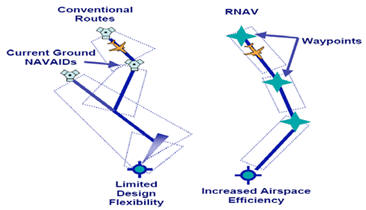|
|||||||||||||||||
|
|
|
|||
|
By Daniel Baxter |
||||
 |
December 14, 2010 - On Friday the U.S. Department of
Transportation’s Office of Inspector (OIG) issued their
report on the Federal Aviation Administration's (FAA)
oversight of new flight procedures using Area Navigation
(RNAV) and Required Navigation Performance (RNP) and its
use of third parties to develop them.
These technologies are key building blocks for the Next Generation Air Transportation System. It will provide shorter and more direct flight paths, improve airport arrival rates, enhanced controller productivity, fuel savings, and reduced aircraft noise. OIG conducted their review at the request of the Chairman of the House Subcommittee on Aviation, who stated that a clear understanding of third-party roles is needed before they can be expanded. |
|||
|
Overall,
OIG found that the role of the two third parties the FAA had
approved to develop RNP procedures remains unclear, as well as
FAA's strategy for implementing timely, high-value routes using
in-house resources. The
FAA has also not fully established an oversight program for
third parties, defined the staffing levels needed to oversee
them, or finalized key guidance to industry on qualifications to
become a third-party developer.
OIG made
eight recommendations to help the FAA effectively implement and
coordinate RNAV/RNP procedures and establish an oversight
program for third parties. Overall, the FAA's response met the
intent of most of their recommendations; however, OIG has
requested that FAA provide additional clarifying information for
three of them.
FAA has
clarified its role in developing new RNP procedures, stating
that it will primarily rely on its own resources rather than
third parties. Therefore, the role of the two third parties FAA
has approved to develop RNP procedures remains unclear, as well
as FAA’s strategy for implementing timely, high-value routes
using in-house resources. Thus far, the FAA has mostly delivered overlays of existing routes that do not provide shorter flight paths to alleviate airspace congestion, a major industry concern. This is because the FAA has mainly focused on developing a targeted number of procedures each year, not measuring user benefits. |
||||
|
As a result,
airlines have not widely used the FAA’s RNP procedures and state that
third parties may provide additional technical expertise to develop the
procedures they need. The FAA contends that it has the technical
expertise to deliver more efficient procedures without third parties but
has yet to assess its in-house skill mix.
The FAA also has
not fully established an oversight program for third parties, defined
the staffing levels needed to oversee them, or finalized key guidance to
industry on qualifications to become a third-party developer. Such
guidance is essential, as third parties would perform procedural
development and maintenance functions historically performed solely by
FAA.
In 2007, the FAA’s
Flight Standards Service established a third party oversight office, but
it will be difficult to determine how many staff this office will need
until the FAA better defines the extent of third party use. The FAA also
faces resistance to the third-party program within its Air Traffic
Organization (ATO) Office of Aviation Systems Standards and
organizational barriers among various lines of business that could delay
new, comprehensive oversight policies.
Thus far, these
problems have impeded the FAA’s ability to oversee its own procedures,
which raises questions as to how effectively the FAA can monitor third
parties. Without a coordinated oversight system in place, the potential
for operational and safety risks increases. NextGen will rely on new routes and procedures that primarily use satellite-based navigation and on-board aircraft equipment to navigate with greater precision and accuracy. These new routes and procedures are commonly referred to as RNAV and RNP. For RNAV, pilots can use a combination of Global Positioning System (GPS) and other self-contained systems on-board aircraft to fly any desired flight path by reducing the limitations imposed by ground-based navigation systems. |
|
|
| ©AvStop
Online Magazine
Contact
Us
Return To News
|
|

